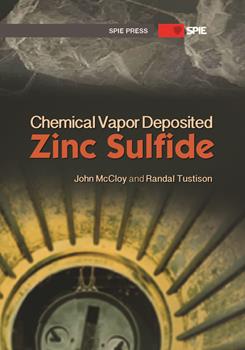Zinc sulfide (ZnS) has shown unequaled utility for infrared windows that require a combination of long-wavelength infrared (8-12 μm) transparency, mechanical durability, and elevated temperature performance. Its unique set of properties extends its usefulness to electroluminescent phosphors, optical thin films used for filters and antireflection (AR) coatings, as well as various other opto-electronic applications. High-optical-quality, chemical vapor deposited ZnS windows several millimeters thick transmit visible light and so have received attention as candidates for multi-spectral windows.
Naturally occurring zinc sulfide is well known as the primary ore of zinc. The common names for the cubic form of ZnS all come from its superficial resemblance to galena (lead sulfide, PbS), but ZnS does not yield any metal when smelted. It was therefore called "blende" or "zincblende" (from the German blenden, "to deceive" or "to blind"), or "sphalerite" [from the Greek δφαλερoζ (sphaleros), "deceptive" or "treacherous."] A special white, transparent, or colorless variety of sphalerite from Franklin, New Jersey, and Nordmark, Sweden, is called cleiophane, which is nearly pure ZnS with only traces of cadmium. Mineral sphalerite tends to have a large component of iron and manganese, and some specimens are very black, so-called "black jack." Mineral cleiophane and sphalerite exhibit different-colored fluorescence under short-wavelength and long-wavelength ultraviolet light, and are of interest to the mineral collector. Wurtzite is a less common hexagonal form of ZnS, named after the French chemist Charles-Adolphe Wurtz (1817-1884) by C. Friedel when it was first identified from a Bolivian silver mine. Mineral hexagonal zinc sulfide containing significant amounts of cadmium is known as pribramite. Hexagonal zinc oxysulfide has been called voltzite or voltzine, though these terms have been used to describe a lead oxysulfide as well.
Bulk ZnS for infrared windows is traditionally manufactured by chemical vapor deposition (CVD) in large reactors. Deposition temperature and mole fractions of the reactants, H2S gas and Zn vapor, have a large influence on visible scatter and absorption. These effects have been ascribed to electronic defects in the bandgap, hexagonal phase ZnS, and residual porosity, but the exact mechanisms have never been adequately explained.
A multispectral form of ZnS can be created by taking traditionally grown polycrystalline CVD ZnS, which is visibly yellow and opaque, and subjecting it to a post-deposition heat treatment under pressure. The heat and pressure result in recrystallization of the CVD ZnS, large grain growth, and a visibly clear and colorless product. The kinetics of this post-process, as well as the dependence on the platinum foil that typically encases the ZnS during heat treatment, remain
poorly understood. It is known that CVD materials grown under different conditions do not behave identically when subsequently heat treated.
The purpose of this book is to review the physical properties of CVD ZnS and their relationship to the chemical vapor deposition process that produced them. We begin with the physics and chemistry of ZnS itself, including its many polytypes. This establishes a basis for understanding the defect structure and how it influences observed properties. Attention is then turned to the CVD process and the resulting forms of ZnS with properties that vary widely with processing conditions. To understand these variations, an in-depth look at the material microstructure follows, including the effects of post-deposition
heat treatments.
For optical applications, the optical transmittance is of primary importance. ZnS intrinsically exhibits very broadband transparency beginning in the ultraviolet and extending through the infrared. This intrinsic transparency, coupled with modest mechanical durability, makes it unique among available infrared window materials. CVD ZnS optical properties are discussed, including the effects on these optical properties of post-deposition heat treatment, with comments on mechanisms for transparency improvements.
Finally, because the CVD process itself is central to the development of this material, a brief history of this process is presented, beginning with its use in the 19th century as a coating technology. The evolution of CVD as a bulk-materials
process came later, and only by the mid-twentieth century was it beginning to be utilized to produce CVD-formed products (most notably pyrolytic graphite). This development was an important milestone, as it put in place the process technology that was critical to the subsequent development of CVD ZnS. We offer this information as a historical note to explain the success of the CVD ZnS process as well as subsequent improvements in the process, including post-deposition heat treatments, but will not focus explicitly on the CVD process technology used to produce ZnS commercially today.
John McCloy
Randal Tustison
March 2013



